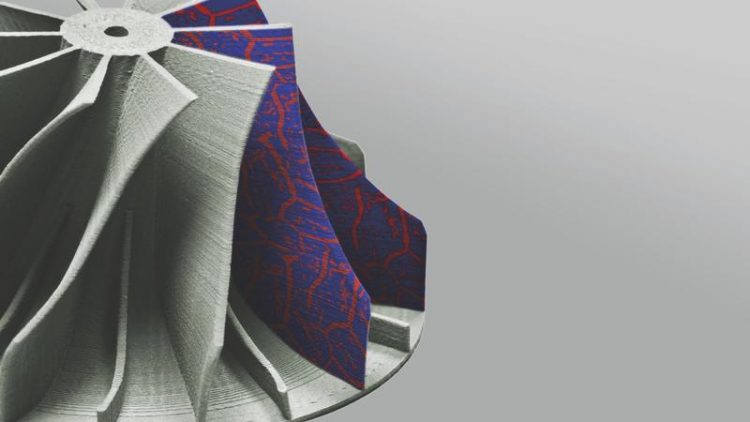High entropy alloys for hot turbines and tireless metal-forming presses

For the first time, scientists at Fraunhofer IWS printed 3D high-entropy demonstrator structures made of the Cantor alloy "CrMnFeCoNi" using the Fused Filament Fabrication (FFF) process. © Fraunhofer IWS Dresden
A new class of materials promises many innovations in aviation, turbine construction and other branches of industry: High entropy alloys (HEA) are metals in which five or more elements are atomically bonded in similar proportions. Properly designed, they are harder, more heat-resistant and lighter than steel, aluminum and other classic materials.
For about 15 years, engineers around the world have been trying to make these innovative materials ready for series production. But high-entropy alloys are still too expensive and difficult to process.
The Fraunhofer Institute for Material and Beam Technology IWS Dresden is therefore now inviting experts to a symposium in March 2020 to demonstrate how they can overcome these problems – for example through industrial 3D printing, in other words “Additive Manufacturing”. Fraunhofer IWS will give a first insight with the lecture “High entropy alloys for Additive Manufacturing” on November 21, 2019, 2:15 p.m. at the “TCT Introducing Stage” during the “Formnext” trade fair in Frankfurt am Main, Germany.
The new conference format is called “1st HEA Symposium: Potentials for industrial application”. Prof. Christoph Leyens, head of the Fraunhofer Institute for Material and Beam Technology IWS and director of the Institute for Materials Science at the Technical University of Dresden, explains: “We want to connect basic researchers and users. Because we keep noticing that many companies are not even aware of this new class of materials. High entropy alloys have great economic and technological potential.”
Classical alloys such as steel have been known since ancient times and produced industrially for over 150 years. In addition to iron, steel contains small amounts of carbon, manganese, nickel, vanadium and other elements. These tiny admixtures influence the hardness, elasticity, forgeability and other properties of steel.
Quintet of elements
High entropy alloys, on the other hand, have only been in the research and engineering focus since 2004. They consist of at least five different components, each in high proportions. These can be aluminium, titanium, iron, chromium or nickel, for example, but also completely different elements, also in combination with nitrogen or carbon – then ceramics are produced.
“Some of these alloys, consisting of elements such as aluminum, titanium, niobium, hafnium and vanadium, are suitable high-temperature materials for turbines,” says organizer of HEA Symposium, Dr. Jörg Kaspar, who heads the research group for Materials and Failure Analysis at IWS.
“This enables more efficient power plants and aircrafts to be designed that consume less gas or fuel. Other compounds are more suitable for lightweight construction”. Ceramic HEA coatings would also make the enormous sheet metal forming tools in the automotive industry more resistant to wear and heat.
Manual brewery would take thousands of years
However, there are still some technological problems to be solved before such alloys become suitable for mass production – and this is where the expertise of IWS researchers comes into play. “High entropy alloys are conceivable in many variations,” explains Jörg Kaspar. “Anyone who wanted to test them all individually would need several thousand years to do so.” The Dresden-based Fraunhofer analysts have therefore further developed methods to quickly produce samples from various HEA compositions and automatically determine hardness, strength and other properties.
This is made possible by “additive production facilities” that transport their HEA ingredients from several containers with iron, chromium, nickel and other elementary powders. A laser melts these substances and carries the desired mixture onto a sample plate. The machine then takes, for example, less iron and more chromium for the next sample, tests the influence on the hardness of the new HEA, and subsequently varies the recipe again.
The system changes the composition in the following steps until the test series is completed. IWS engineers draw on profound experience with these and other HEA technologies: They also master materials that are difficult to process, which otherwise become brittle and susceptible to cracking at room temperature and air influences, in high quality.
In addition, they contribute their expertise in the use of various additive manufacturing processes: These include laser metal deposition systems that expect ingredients in form of powders or wire, but also metal printers or systems that shape metal alloys using polymer support structures.
“Many institutes and companies around the world are working on high-temperature alloys. But in this technological depth like ours, not many can. Especially in HEA processing using additive manufacturing methods, I see ourselves ahead,” summarizes Jörg Kaspar.
Fraunhofer IWS organizes the “1st HEA Symposium for High Entropy Alloys: Potentials for Industrial Application” in Dresden on March 12 and 13, 2019.
More info: https://www.iws.fraunhofer.de/hel-symposium
Dr. Jörg Kaspar
Head of department Materials and Failure Analysis
Fraunhofer Institute for Material and Beam Technology IWS
Winterbergstraße 28, 01277 Dresden
joerg.kaspar@iws.fraunhofer.de
Phone +49 351 83391-3216
https://www.iws.fraunhofer.de/en/pressandmedia/press_releases/2019/presseinforma…
Media Contact
All latest news from the category: Event News
Newest articles

NASA: Mystery of life’s handedness deepens
The mystery of why life uses molecules with specific orientations has deepened with a NASA-funded discovery that RNA — a key molecule thought to have potentially held the instructions for…

What are the effects of historic lithium mining on water quality?
Study reveals low levels of common contaminants but high levels of other elements in waters associated with an abandoned lithium mine. Lithium ore and mining waste from a historic lithium…

Quantum-inspired design boosts efficiency of heat-to-electricity conversion
Rice engineers take unconventional route to improving thermophotovoltaic systems. Researchers at Rice University have found a new way to improve a key element of thermophotovoltaic (TPV) systems, which convert heat…



